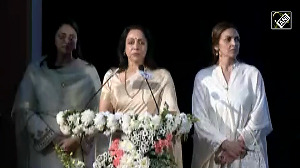Could the MPCE survey results be used as a basis of reconstructing the Consumer Price Index with new weights, asks Madan Sabnavis.

The Survey on household consumption expenditure has long been expected after being delayed due to the pandemic.
The results of the monthly per capita consumption expenditure (MPCE) of households are interesting, as they shed some light on the state of the rural and urban economies and allow for some broader thinking.
The Survey shows that the gap between per capita monthly consumption expenditure between the rural and urban populations has narrowed, which is a positive sign, as this is the way to go when it comes to ensuring broad-based growth.
Here, the Survey provides two sets of numbers, one referring to standalone expenditure of households and the other with imputed expenditure when the free support goods and services provided by the state are included.
Hence, there is a lot of transparency here. But surprisingly, the difference between the two estimates for 2022-23 is Rs 97 in rural areas and Rs 62 in urban areas.
These numbers could be on the lower side given that the free food scheme involves five kilos of cereals, which have a minimum support price of above Rs 20/kilo.
Add to this the free liquefied petroleum gas cylinders and power provided by various levels of government, and the difference should have been much higher.
The Survey points out that the growth in rural consumption based on the per capita numbers has been higher over the last decade for which comparison is provided.
It was 2.69 times for rural India, compared to 2.47 for urban India based on the imputed numbers.
This may be attributed to more transfers from the state to the citizens, as the support provided aligns with the stress levels.
Also, 2022-23 was a year when the Covid-induced schemes continued with the same rigour.
Further, schemes like employment under the Mahatma Gandhi National Rural Employment Guarantee Act and PM Kisan are essentially rural-based schemes that do not have equivalents in urban areas.
This growth in rural consumption, however, is lower than the growth in nominal gross domestic product, which was 3.12 times, and private final consumption expenditure, which was 2.93 times.
Digging further into these results, two things stand out. The first is the difference across states.
Looking at the monthly per capita consumption expenditures (MPCE-I) with imputed values, the numbers stand at Rs 3,860 and Rs 6,521 for rural and urban people.
The smaller states do have high values, given the lower size of the population.
But among the larger states there are considerable differences.
The southern states, namely Tamil Nadu, Andhra Pradesh, Kerala, Telangana and Karnataka, have an MPCE above the national average, which reveals to an extent the relentless efforts put in by the state governments over the years to elevate the standard of living.
Tamil Nadu and Kerala have the highest MPCE among the larger states for rural community, with Rs 5,457 and Rs 5,960.
In fact, for the latter, the higher standard would be largely due to the flow of remittances from expat citizens.
Among the northern states, Punjab and Haryana do very well in rural consumption, which can be attributed to the strong agricultural economies.
However, Uttar Pradesh, Madhya Pradesh, and Bihar are laggards in both areas, while Rajasthan does well in rural areas but falters in urban consumption.
Maharashtra does better than the national averages but Gujarat, which is a very prosperous state in terms of gross state domestic product, falls marginally short in rural consumption and just about remains above the average for urban consumption.
Odisha and West Bengal have lower than national averages in both the zones.
The basic message here for the governments is to concentrate on the requisite areas to ensure that a better balance develops over the next decade or so.
The second major revelation is the composition of consumption over this period across both rural and urban areas.
Historically, it has been seen that when societies evolve, the consumption pattern tends to shift from necessities to comforts and luxury goods and services.
This is natural because there are limits to consumption of food and clothing items.
As incomes increase, there is a tendency to allocate more for non-essentials.
The MPCE Survey shows that this has prevailed across both segments.
For the last decade, the MPCE-I for food has moved down from 53 per cent to 47 per cent for rural India, and from 43 per cent to 40 per cent for urban India.
The change in pattern is quite similar for both the segments.
There are higher expenses provided for durable goods, conveyance, and rent, while that of basic food products like cereals has come down.
Interestingly, on the food side, there is a tilt towards milk products, fruits or dry fruits (for urban), beverages and processed foods.
This shows that the FMCG companies have made significant inroads into rural India too with customised products to garner a fair share of the market.
Also, the fact that people prefer to move to durable goods such as vehicles, fridge, and TVs, even in rural India, shows that there has been a strong demonstration effect , which along with the strong power of advertising, has reached the interiors and brought about a balance in the economic landscape.
While these results are very significant as it does show the new face of rural India, they can also be a bit provocative.
Could this be used as a basis of reconstructing the Consumer Price Index with new weights?
This is pertinent because if the share of food items has come down in both rural and urban consumption baskets, it logically should be reflected in the weights of the inflation index.
Here, one needs to consider that 2022-23 was not a normal year, which is what is usually considered when constructing any price index.
Both 2020 and 2021 were pandemic years and the following year saw a surge in pent-up demand.
This surge was first seen in manufacturing, with the consumer goods industry performing well due to this phenomenon.
Subsequently, in FY23, the services sector saw a surge in demand for travel and hospitality.
Things have plateaued in FY24, as can be seen in the flat growth in sales in India Inc for non-infrastructure industries.
Hence, using these results as a basis for making 2022-23 a base year will introduce a significant bias.
Hence, the MPCE numbers should be viewed more as a standalone statistic.
Madan Sabnavis is chief economist, Bank of Baroda, and author of Corporate Quirks: The darker side of the sun.
Feature Presentation: Aslam Hunani/Rediff.com











